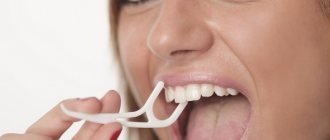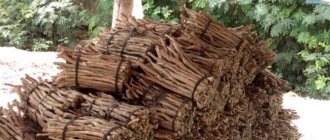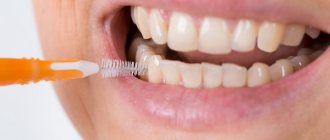Cleaning your tongue is the first step in the fight against periodontal disease. It has been clinically proven that daily removal of plaque from the surface of the taste organ can slow down the formation of dental plaque, normalize the microflora of the oral cavity and reduce the number of adhesive forms of cocci that provoke the development of caries. To effectively clean your tongue, you must use a special brush.
Why is it necessary to clean your tongue?
Keep in mind! The surface of the human tongue does not have a uniform structure; plaque forms on it.
This provokes the formation and proliferation of microbes and bacteria , they cause inflammatory processes.
When human immunity is weakened, the opportunistic flora of the oral mucosa can become pathogenic, which is fraught with the manifestation of staphylococcus and streptococcus.
The tongue needs to be cleaned in order to:
- remove plaque and pathogens.
- Massage the receptors on the tongue to improve the functioning of internal organs.
- Prevent dental diseases.
- Remove unpleasant odor from the mouth.
- Improve taste sensations when eating food.
Stay up to date! Failure to maintain hygiene of this organ inevitably leads to the occurrence of dental diseases such as:
- caries;
- gingivitis;
- tartar, stomatitis;
- periodontal disease;
- unpleasant smell.
Dentists recommend cleaning the surface of the tongue daily.
A coating on the tongue reduces a person’s perception of the taste of food because the activity of taste buds decreases.
Is it possible to clean plaque from your tongue yourself?
A healthy person's tongue normally has a pink tint and is slightly moist. With improper hygiene, a physiological white coating can form on its surface, which can be easily removed by yourself. But in some cases, the reasons for the formation of microbial film are pathological. This could be an infectious disease, periodontal disease and any inflammatory processes in the oral cavity, disturbances in the gastrointestinal tract or respiratory system, or decreased immunity. If the reason for the appearance of a film on the tongue is pathological, in this case it would be correct to seek help from a dentist.
The following signs will help you understand whether the film on the tongue is a normal physiological condition or a symptom of some disease.
"Healthy" plaque:
- yellowish or white;
- covers the tongue with a thin layer, through which the lingual papillae are visible;
- there is no pungent odor from the mouth or pain;
- appears periodically, due to some factors (for example, thirst);
- it can be easily removed with a brush.
Signs that indicate pathology:
- grey, brown or yellow;
- lies in a dense opaque layer;
- has a sour or bitter taste;
- It cannot be removed with a brush.
What is a tongue brush?
Note! The brush is equipped with a flat, rounded nozzle, on the surface of which there are small bristles, which allows for thorough and accurate cleaning.
Some models have silicone or plastic strips on the back side that gently act on the surface of the tongue.
The handle is made of elastic plastic.
Products may differ in shape, which does not affect the quality of cleaning.
The design and material from which the product is made eliminates the appearance of a gag reflex.
The period of use of a hygienic device with bristles is 3 months .
Rules for using scrapers and brushes
How to properly use a scraper to remove plaque from the surface of the tongue? To do this, open your mouth and place the cleaning blade as far as possible to the root. Make sure that this action does not provoke vomiting. How deep you can place the instrument in the mouth depends on the structure of the jaw.
Then you need to smoothly move the scraper to the tip of the tongue. Do not make sudden rough movements or press hard on the device: this can injure the mucous membrane. When the device reaches the tip, it must be immediately rinsed under running water. It is also necessary to rinse your mouth so that no removed deposits remain in the cavity.
Moving the scraper from the tip of the tongue to the root is strictly prohibited. This movement will return the removed plaque to its original place.
How long does it take to clean the surface? One or two minutes is enough: it all depends on the degree of neglect of the mucous membrane.
Using a regular toothbrush
Some models of toothbrushes have a ribbed back surface, which can be used to gently clean the mucous membranes. How to do this correctly? After cleaning your teeth, you need to apply a pea of toothpaste to the surface of your tongue and begin. Make circular movements with the brush, moving from root to tip.
A toothbrush with a scraper on the back does not provoke a gag reflex.
If you are going to use a brush to remove deposits, choose one with soft bristles. You should not touch the surface of the tongue with even medium-hard bristles, as it can cause micro cracks that are invisible to the eye. Any damage to the surface of the mucosa opens access to pathogenic bacteria. Therefore, do not experiment with stiffness, take the right brush straight away.
For hygiene, you can use other types of toothbrushes - ultrasonic and electric.
A toothbrush with a scraping surface is less effective in use, since it does not immediately cover the entire area to be cleaned. A tongue scraper does its job much faster, but may cause gagging. Therefore, when choosing a cleansing tool, take into account the structural features of your body. If your gag reflex is not open, you can safely use a scraper instead of a toothbrush.
Varieties
It is worth noting! In pharmacies, retail chains and online stores, you can purchase various devices for cleansing this organ:
- toothbrush with a rubberized insert on the back side . It is the tool for cleaning the tongue. The downside of this device is the convenience of the cleaning process and the appearance of a gag reflex.
- A spoon for cleaning this organ is an instrument made of an elastic nozzle with a tip, made in the form of a spoon. These spoons are often used as attachments for electric toothbrushes.
- Ordinary silver spoons are also ; it should be individual and used only for oral care.
- A scraper brush is a flat attachment with a plastic handle; its tip can be made in the form of a spoon, oval or triangular. The surface of the brush has bristles that are smaller than the bristles on a toothbrush. Some models have convex silicone strips on the reverse side.
For your information! Several types of scrapers are produced:
- with one element, arc-shaped . The advantages of the device are its convenient location on the tongue and quick cleaning in a few movements. The downside is that it often provokes a gag reflex.
- Flat scraper with two cleaning elements . It causes gagging much less often, quickly clears plaque and does not create discomfort to the root of the tongue.
- Complex shape with corrugated surface . Can be manufactured in various versions. In addition to quickly cleaning the organ, it massages and does not cause gag reflexes.
During cleaning, the receptors of the tongue are massaged, thereby activating and stimulating the work of your internal organs.
Benefits of Cleaning Your Tongue Regularly
Hygiene of the surface of the tongue is not a tribute to fashion and not just another invention of manufacturers of oral care products. Special attention has been paid to this for a long time. The tongue scraper was made from turtle shell or ivory. Later they began to be cast from silver. The medieval physician Avicenna wrote about the benefits of hygienic tongue care in his treatises. In the time of Avicenna, split sticks of wood rich in essential oils or small cypress cones were used for hygiene.
In India, the benefits of mucosal hygiene were also correctly assessed. Yogis used wooden spoons or cleaned the mucous membranes with three fingers wrapped in cotton.
Regular tongue care helps:
- strengthening the immune system;
- normalization of taste perception of food;
- prevention of bad breath.
How does oral hygiene improve the immune response? Toxic substances—bacterial waste—accumulate in the white coating. Unremoved toxic substances are absorbed into the blood over time, forcing the immune system to fight their harmful effects. Accordingly, removing toxins does not burden the immune system, which helps strengthen it.
Taste buds are located throughout the surface of the tongue, it is thanks to them that a person feels and recognizes taste. Bacterial sediment on the surface clogs the taste buds, reducing the pleasure of eating food. Freeing the taste buds will restore the correct perception of foods.
Most bacteria are found on the root of the tongue. Thanks to the convenient shape of the sediment scraper, you can get rid of many pathological microorganisms and achieve fresh breath. In addition to eliminating deposits, the cleansing brush has a gentle massaging effect, promoting high-quality blood circulation in the oral cavity.
The tongue can be used to diagnose diseases, so its cleanliness will indicate a healthy body. Regular cleansing will bring not only aesthetic benefits, but will also promote health and allow you to recognize the onset of diseases of the internal organs. If a lot of deposits have accumulated on the mucous membrane, this indicates a serious internal disease.
Types of plaque and disease
- A thin white coating indicates a decrease in the body’s protective functions;
- a coating of cheesy consistency signals the development of a fungal infection in the oral cavity;
- mucous membrane in cracks warns of the development of gastritis;
- a gray tint of deposits indicates a severe complication of the existing disease;
- a yellow tint of deposits indicates problems with the gastrointestinal tract and liver;
- a green tint indicates problems with the liver, which is not able to cope with its functions;
- a brown tint occurs in alcohol-dependent people or in cases of problems in the gastrointestinal tract;
- a black tint occurs in heavy smokers or in people with serious disorders of the liver and gastrointestinal tract.
The advantage of regular use of a scraper is precisely the timely diagnosis of the onset of diseases.
Popular models
Curaprox
For reference! This is a set that consists of two scrapers, narrow and wide.
The narrow scraper has one cleaning surface to gently remove plaque from the tongue. Wide, consists of two “blades”:
- smooth - designed to clean the root of the tongue and remove accumulations of bacteria.
- serrated - cleans the front part of the tongue from plaque.
The shape of the hygiene instruments is designed to prevent the gag reflex .
Low-allergenic plastic is used in production.
Meridol Halitosis
A brush is a scraper, on the base of which in the upper part there are short rubber bristles arranged in two rows . At the bottom of the base there are plastic scrapers in the form of four stripes.
Need to know! This type of brush not only removes plaque, but also massages.
Miradent
This device resembles a spoon on a curved handle for more convenient cleaning .
The nozzle contains bristles and a plastic arc.
Trisa
A double-sided scraper is designed for cleaning and massaging the organ in question.
On one side there is a hard plastic edging designed to remove plaque. On the other side there is a soft rubber edging for massage .
Freshness
Keep in mind! At the top of the tool are two plastic curved scrapers.
Smooth, cleanses the surface of the organ from persistent plaque. Embossed, designed for fine, delicate cleaning.
Tongue cleaners
There are 3 main types of tongue cleaning devices: scrapers, brushes and spoons. They all vary in size, material, design and head type. The choice of device should be based on individual needs and preferences.
If you don't have special tools, you can use a teaspoon to clean your tongue. A regular toothbrush with a ribbed surface will also work. However, the use of such devices for such a specific hygienic procedure should be temporary, since they injure the mucous membrane of the tongue and are less effective in removing plaque than specialized instruments.
How to choose a tongue brush
When choosing a tongue cleaner, it is recommended to pay attention to the following characteristics:
The stiffness of the bristles. Soft brushes should be preferred. The medium-hard bristles damage the back of the tongue and cause microbleeding after just a few brushing strokes.- Material of manufacture. The majority of cleaners are made of plastic, but some of them use silver. When in contact with saliva, the metal has an antibacterial effect.
- Shape and size of the cleaner. It is better to choose a brush with a long handle, adapted to the shape of the tongue.
Many stores sell tongue cleaning kits that include antibacterial gels. The use of gels together with a brush increases the cleaning efficiency and helps to maintain fresh breath for a longer time.
How to choose a tongue scraper
Scrapers are in demand among people with a strong gag reflex. Externally, the head of such a device resembles a spatula. Due to the perpendicular arrangement of the “blades” to the surface being cleaned and the flat shape, the tongue scraper does not irritate the mucous membrane and does not cause nausea.
When choosing scrapers, you should focus on the following parameters:
- Material of manufacture. Most tongue scrapers are made of plastic, copper or silver. Plastic scrapers are less durable than metal ones : they must be replaced every 7–14 days. Copper and silver models must be disinfected in boiled water.
- Easy to wash. The spatula needs to be rinsed after each cleaning movement, so it is important that it can be easily rinsed under running water.
- Blade length and handle properties. A cleaner equipped with an anti-slip handle and corresponding to the size of the tongue is most convenient to use.
Many manufacturers produce combined hygienic devices - brushes and scrapers. On the working surface of this cleaner there are “blades” and soft bristles. The product has a round shape and resembles a spoon.
Irrigator attachments
Irrigator is a device for hydro-jet cleaning of teeth and oral cavity. Removal of food residues and other deposits is achieved by applying a thin stream of water under high pressure. The effectiveness of hydrocleaning lies in the ability to clean hard-to-reach areas of the oral cavity.
A special spoon attachment has been developed to clean the tongue with an irrigator. The product is manufactured with an emphasis on performance and comfortable use. The spoon does not injure the surface being cleaned, does not cause a gag reflex, and cleans the upper and lower sides of the tongue. It is recommended to remove plaque using a spoon attachment after brushing your teeth.
The use of any tongue cleansing device requires caution. Do not apply excessive pressure on the surface to be cleaned or use a non-sterile cleaner. It is equally important to follow the instructions for use, since some products have particularities of use and contraindications.
How to use?
After brushing your teeth and rinsing your mouth with water , you should begin cleaning your tongue.
Using a special brush, you need to make light sweeping movements , starting from the base of the organ and slowly moving to the tip .
You should first clean one side and then the other side of the tongue.
The next movement should be made not in the longitudinal, but in the transverse direction , from the base to the tip. Then sweep along the side parts of the organ to be cleaned using sweeping movements.
When brushing your tongue, rinse the brush with clean water to remove plaque.
Important! During the cleansing process, you can use toothpaste, especially for people with gastrointestinal, kidney, liver diseases and smokers.
It is these categories of people who are susceptible to additional plaque formation with a pronounced unpleasant odor.
It is not recommended to use pastes with abrasive particles and a strong, minty taste, as they can cause irritation and discomfort to the delicate tissues of the organ.
At the end of the procedure, you can rinse the mouth using an antiseptic gel.
When cleaning, do not press the hygiene instrument too hard to avoid damaging the sensitive surface of the tongue.
Dentists recommend cleansing this organ twice a day. The duration of the procedure is several minutes.
However, it not only relieves a person of unpleasant odor from the mouth, but is also a preventive measure to eliminate pathogenic microbes and bacteria.
general information
We all know that we should brush our teeth twice a day.
A good toothpaste and brush are faithful assistants in maintaining a healthy and clean oral cavity. However, not all of us are aware that not only our teeth, but also our tongue needs daily cleaning. Thanks to this hygienic procedure, we remove harmful microorganisms, food debris, and toxins that accumulate during sleep. Any dentist will tell you that having a tongue scraper is just as important as having a toothbrush or floss.
Should children have their tongues cleaned?
Know! The recommendations of pediatricians are clear. Children should begin the brushing procedure as soon as their first teeth appear. Since they are too young at this age, the cleaning process must be carried out by parents.
For these purposes, finger pads for parents , at the end of which there are soft silicone bristles or a relief plate.
The procedure is carried out according to the technique for adults, and the cleaning time must be reduced.
It is not recommended to use pastes and gels until the child learns to rinse the mouth independently.
Dangers and Consequences
Keeping your tongue free of bacterial plaque helps maintain oral health.
Note! However, if you ignore this useful procedure, you may encounter the following consequences:
- diseases caused by fungi - in the form of white marks on the tongue;
- periodontitis – leads to tooth loss and gum inflammation;
- spotted tongue due to staining from drinks;
- unpleasant odor caused by bacteria located on the back of the tongue;
- impaired taste due to a large number of pathogenic bacteria and dead cells.
What to clean with? Medicines and devices
To get rid of plaque on the tongue, it is important to maintain oral hygiene, especially at home .
When brushing your teeth, you should clean the palate, the inside of your cheeks, and pay special attention to the surface of your tongue .
How exactly can you carry out special hygiene? The following products and devices will help with high-quality cleansing
Toothpastes
Cleaning the tongue from plaque is carried out using toothpaste or a special gel with wound-healing properties.
Know! Among the best products, experts highlight “Splat” and “Aquafresh” pastes, which have an antibacterial effect and do not harm the health of the oral cavity and the body as a whole.
Gel "Mitrogil Denta" is suitable for people with high sensitivity and will effectively cleanse the tongue of various formations.
Using toothpaste to destroy unpleasant deposits does not require special skills and consists of several simple steps:
- Using circular movements without pressing, thoroughly clean the tongue.
- Move to the palate and inner cheeks.
- Rinse your mouth with a medicinal solution or plain water.
Toothbrushes
You can use either a regular toothbrush or a brush with silicone bristles on the back of the working head.
For effective cleaning, dentists recommend Colgate 360 and Oral-B Pro Expert toothbrushes , which do an excellent job of removing bacterial deposits.
Important! After finishing brushing your teeth, you should position the brush so that the rubberized pad touches the affected surface.
Move the brush several times along the tongue in one direction, and then rinse the mouth.
Special dental trays
A dental spoon consists of a nozzle and a spoon-shaped tip.
Most often, the device is used as a replacement attachment for an irrigator or electric brush.
also perform the tongue cleansing procedure after brushing your teeth.
To do this, you need to run the working surface of the nozzle along the tongue surface from the back to the tip.








